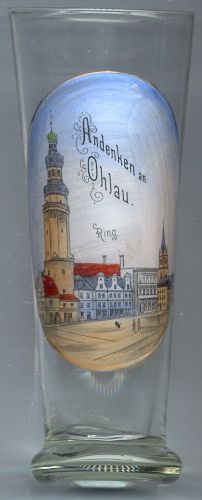

|
| POLSKA | POLAND |
| województwo: Dolnośląskie | voivodship: Lower Silesia |
| powiat: Oława | county: Oława |
 Oława (German: Ohlau) is situated at an elevation of 120 m between the rivers Odra (Oder) and Oława (Ohle) southeast of
Wrocław in Lower Silesia. The place began to develop during the early 12th century at a site that was protected by the
two rivers. It was first mentioned as Oloua in a document of 1149 confirming its donation to the abbey of St. Vincent in Wrocław.
In 1206 Oława became one of the residence towns of the dukes of the Piast dynasty, who also granted Oława the status of a town in
1234. During its history, Oława was destroyed completely three times. In 1241 it was destroyed by the Tatars, in 1448 by the Hussites,
and again in 1634 during the Thirty Years' War. After the Polish King Kasimir III had renounced his rights on Silesia with the
contract of Trenčín in 1335, Silesia became a Bohemian fief. In 1526, when the Habsburgs gained the Bohemian crown,
Silesia came under Austrian sovereignty. After the death of the last Piast duke in 1675, Oława ceased to be a residence town. Together
with most of Silesia, the town became part of Prussia in 1741. The 18th and 19th centuries were a period of economic growth and Oława
became well-known as a centre of tobacco-growing. In 1842 the railroad between Oława and Wrocław, the first one in Silesia
(and of modern Poland), was opened. Oława did not suffer much during World War I, but in World War II about 60% of the town
were destroyed. Oława became part of Poland in 1945 and its German-speaking population was expelled. After the war, Oława
became a garrison town of the Soviet Army and remained so until 1992.
Oława (German: Ohlau) is situated at an elevation of 120 m between the rivers Odra (Oder) and Oława (Ohle) southeast of
Wrocław in Lower Silesia. The place began to develop during the early 12th century at a site that was protected by the
two rivers. It was first mentioned as Oloua in a document of 1149 confirming its donation to the abbey of St. Vincent in Wrocław.
In 1206 Oława became one of the residence towns of the dukes of the Piast dynasty, who also granted Oława the status of a town in
1234. During its history, Oława was destroyed completely three times. In 1241 it was destroyed by the Tatars, in 1448 by the Hussites,
and again in 1634 during the Thirty Years' War. After the Polish King Kasimir III had renounced his rights on Silesia with the
contract of Trenčín in 1335, Silesia became a Bohemian fief. In 1526, when the Habsburgs gained the Bohemian crown,
Silesia came under Austrian sovereignty. After the death of the last Piast duke in 1675, Oława ceased to be a residence town. Together
with most of Silesia, the town became part of Prussia in 1741. The 18th and 19th centuries were a period of economic growth and Oława
became well-known as a centre of tobacco-growing. In 1842 the railroad between Oława and Wrocław, the first one in Silesia
(and of modern Poland), was opened. Oława did not suffer much during World War I, but in World War II about 60% of the town
were destroyed. Oława became part of Poland in 1945 and its German-speaking population was expelled. After the war, Oława
became a garrison town of the Soviet Army and remained so until 1992.
The  town hall with its characteristic tower [left]
was built in 1637–1668. The clock in the tower was installed in 1728. The neo-Classicist part
of the town hall [the red roof in the background] was built in 1823–1830.
town hall with its characteristic tower [left]
was built in 1637–1668. The clock in the tower was installed in 1728. The neo-Classicist part
of the town hall [the red roof in the background] was built in 1823–1830.
The  parish church [background right]
was first mentioned in 1201. The Gothic chancel was finished around 1300, the nave dates from 1587–1589.
After the church had suffered severe damages in 1634 it was rebuilt until 1691/92.
The original church tower, which had collapsed during a thunderstorm in 1881, was replaced in 1886 by
a new, neo-Gothic tower (62 m high). From 1534 until 1945 (with the exception of 1699–1707)
the church served as the Prostestant parish church (St. Blasius and Sperantus).
Since 1945 it is the Catholic parish church (Our Lady of Consolation).
parish church [background right]
was first mentioned in 1201. The Gothic chancel was finished around 1300, the nave dates from 1587–1589.
After the church had suffered severe damages in 1634 it was rebuilt until 1691/92.
The original church tower, which had collapsed during a thunderstorm in 1881, was replaced in 1886 by
a new, neo-Gothic tower (62 m high). From 1534 until 1945 (with the exception of 1699–1707)
the church served as the Prostestant parish church (St. Blasius and Sperantus).
Since 1945 it is the Catholic parish church (Our Lady of Consolation).
The mathematician Alfred PRINGSHEIM (1850–1941) was born in Oława.
![[scale]](lineal.jpg)